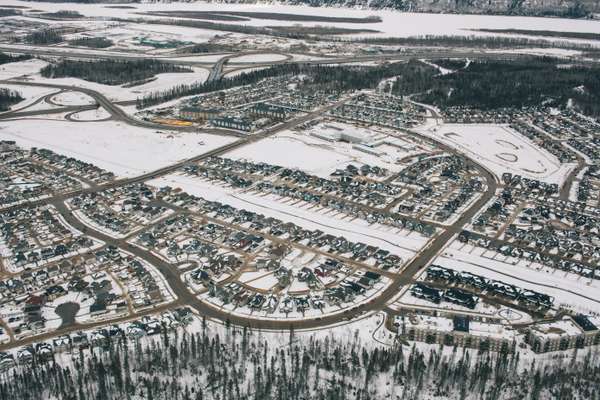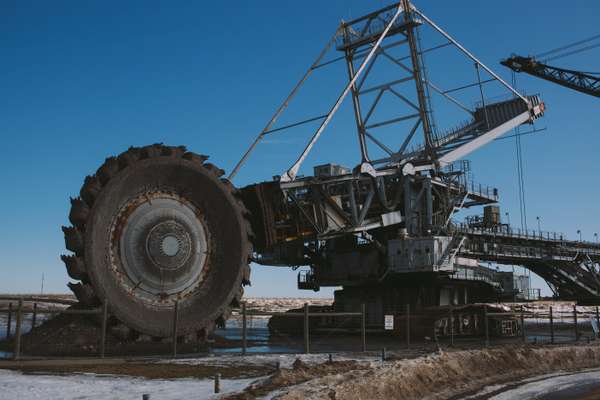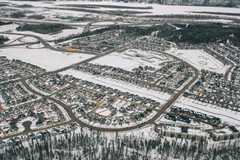Report / Fort McMurray
Crude health
The meteoric growth of tar-sands boomtown Fort McMurray has slowed but it might be just the break this unbalanced town needs.
Flying over northern Alberta’s tar sands, the glassiness of the winter landscape imbues the scene with a feeling of things in suspended animation. Below, the big, black, open pits from which the bitumen is harvested are frosted with waves and tendrils of ice.
From this height the heavy machinery that mines and transports the ore – some of the largest diggers and trucks ever to roam the planet – register as mere toys. Nearby the stacks of a processing plant dreamily puff smoke, the clouds drifting toward the vastness of boreal forest on the distant horizon.
“It’s almost exotic,” says a smiling Arnaud Billard, the chatty French-Canadian pilot of our four-seat Cessna. He is just one of the many migrants from the rest of Canada and abroad lured to the region in recent years by the tar-sands boom. The pay in aviation here, he says, is far above the standard anywhere else. That the otherwise colossal scale of operations here should feel like the inside of a diorama almost frozen in place presents a certain symmetry with the current economic prospects for the controversial tar sands. It is one of the world’s largest single industrial sources of carbon emissions and now contends with a precipitous drop in oil prices. Big firms in the region, such as cnrl, Syncrude and Royal Dutch Shell, are cancelling new projects or expansions of existing ones, their economic viability thrown into doubt.
Though production here approaches almost two million barrels a day, making Canada the largest supplier of foreign oil to the US, the tar-sands industry is especially prone to price shocks. Not only is crude from tar sands dirtier work to produce, it is also far more expensive, largely due to the necessary scale of operations and the intensive process required to extract oil from the bitumen.
It can’t bode well for Fort McMurray, the spirited if much-maligned boomtown only 30km to the south of the nearest tar-sands site. As production and investment have swelled in the past decade, so too has Fort McMurray. The one-time trading post pitched at the confluence of the Clearwater and Athabasca rivers has seen its population nearly treble to just shy of 100,000, and in the process incurred all the usual pressures befitting a boomtown.
With earnings in the tar sands expected to drop by cad$8bn (€6bn) this year, all the makings of a bust are in place. It is already being felt around town, now indiscriminately painted in clay-coloured mud thanks to an early spring thaw. The food bank has seen a sharp increase in demand, running out of supplies months earlier than expected. Shop owners are apt to remark that business has slowed. Even Fort McMurray’s overheated property market is taking a pause, with many new houses and condo units unsold. Despite the cutbacks the mood is calm. In the sprawling industrial parks around Fort McMurray’s periphery, the contractors and suppliers that do business with the oil companies seem no less occupied than usual. “I’m surprised that we’ve stayed as busy as we have,” says Alan Turner, owner of a garage that repairs worn-out equipment parts. Though he adds that everyone is getting squeezed on price as companies press for efficiencies. “The people I talk to seem to be hanging in there. It’s only three months into the downturn so we’re playing it by ear.”
In part that’s because the slowdown has so far mostly affected projects in the development and construction phase – which primarily employ temporary workers from outside the region – while existing sites continue to produce at capacity. But it may also have something to do with the boomtown’s growing maturity and the fact that lessons learned from previous busts mean that Fort McMurray is better positioned to weather a downturn.




Frank Reitz, an estate agent and long-time resident, takes a seat at a boutique coffee shop a few blocks away from the town’s main drag, an unfortunately cheerless thoroughfare of strip malls and chain stores. Reitz points out that when the last big slowdown hit in tandem with the 2008 financial crisis, for many of the newcomers to Fort McMurray it was the first time they had ever experienced a bust. “Now they’ve gone through it before and anyone that had been here longer had seen it already,” he says. “It’s been a little quiet but we’ve been here before and we’ll be here again.”
No other city of comparable size gets scrutinised as much as Fort McMurray. On a global level, the strip-mined environs of the tar sands in its backyard have provided a target for environmentalists battling for action against climate change. Meanwhile, various lurid stories of rampant drug use, prostitution and rowdiness in Fort McMurray have been a staple for Canadian newspapers for a number of years now.
It is familiar boomtown stuff and shouldn’t surprise given that the vast majority of the newcomers have been young men – at a median age of 32 the town’s residents are eight years younger than the Canadian average – and spectacularly well paid ones at that. Routine was that young men came, worked hard, saved money and left but not before helping to foment the town’s bad reputation.
More remarked upon lately is how this city, so notorious for its vices, is beginning to feel almost domesticated. Increasingly, families are choosing to settle here for the long-term, among them a sizeable foreign-born population. Thanks to high wages in the tar sands and its related industries, Fort McMurray boasts a median family income of cad$175,000 (€128,000), by far Canada’s highest. Meanwhile, overdue investments in roads, schools and day-care spaces have made putting down roots more appealing, as has the opening of an impressive recreation centre that would be the envy of any big city.
With oil prices expected to remain sluggish for the foreseeable future, a protracted bust could throw that progress into question. But when monocle visits Melissa Blake, the mayor of Wood Buffalo – a 63,000 sq km municipality that includes the tar sands and Fort McMurray, as well as the aboriginal settlements of Fort Mackay and Fort Chipewyan – she sounds a counterintuitive note. “Times like these strike inspiration,” she says, as though she’s been conditioned to see the silver lining in every bust.
Throughout Blake’s 11-year tenure, even as cash flowed into the pockets of residents, the region’s infrastructure has struggled to keep up with the pace of growth. Housing is a perpetual sore spot; a near-zero vacancy rate turning Fort McMurray’s campgrounds into an archipelago of semi-permanent trailer homes. Demands on the town have been so intense that Blake has, on occasion, called for the local government to temper down the pace of tar-sands development; almost a blasphemy in avowedly free-market Alberta.
Of the last big bust, in 2008, Blake says, “Although it felt like dark days at the time, I don’t remember it now with a heavy heart.” As the population stabilised and labour costs came down, she adds, the municipality was able to catch up on many of its infrastructure needs and focus on bettering quality of life. A major hike in the municipal tax rate paid by tar-sands companies made it possible to do so.
“It proved to be a good time for this community to start gaining some headway,” says Blake. “We’re definitely at a higher plateau now; there’s not the same struggle to keep up but I see a similar opportunity.” Wherever prices may be at the moment, there are projections to one day produce upwards of five million barrels a day, more than double the current output. “We need to think about the population needed here to support that,” says Blake.
One of Blake’s plans is to do something about that dispiriting downtown, though plans to make it more urban and pedestrian-friendly – so seemingly at odds with the motor culture of the place – are mired in controversy. She’s had better luck encouraging the emergence of a vibrant non-profit sector that is helping to take some of the edge off a place that could still feel, until recently, like a rough-and-tumble frontier town.
At the Hub Family Resource Centre in Timberlea, one of Fort McMurray’s new developments, the toy-cluttered playroom is emptying out as carers and parents pick up their toddlers. With an average of 120 babies born at the local hospital per month, high for a city of its size, Hub’s executive director Chantal Beaver notes that Fort McMurray is becoming more family friendly; each year she sees a 20 per cent increase in demand for Hub’s services.
A migrant from Canada’s east coast, Beaver chose to come here and raise her children while also putting her background in family studies to use. “I remember reading this article about how Fort Mac wasn’t a real community; how it was no place to raise a family,” she says. “I knew that wasn’t true. The opportunities that my children have been given here are far greater than they would have had back east.”
A move to bolster social services is a direct result of lessons learned during the last bust. Blake and the city council sought ways to make Fort McMurray more resilient to the unique pressures it contends with, whether in times of rapid growth or economic uncertainty.
Established in 2013, Fuse Social is a base for the municipality’s non-profit organisations. Manny Makia, a Cameroon native and Fuse’s genial executive director, describes its role as being “more proactive to the boom-and-bust cycles Fort McMurray will always face as a single-resource economy, the price of which is controlled by forces outside our control.”
Despite some progress, Makia says social infrastructure is at least five years behind where it needs to be for a population of Fort McMurray’s size. And its boomtown dynamic makes particular issues more pressing: the need for affordable housing, support for victims of domestic abuse, mental-health programmes and settlement assistance for newcomers. He adds that community building can be a challenge in a place dominated by long work hours and the disruptive pattern of shift schedules.
“Transiency is a condition that’s inherent in communities such as Fort McMurray,” says Makia. “But increasingly we’re seeing people stay for the long term. When I came in 2010, I had to explain that I didn’t have a five-year plan. People were already asking when I was going to leave.”


